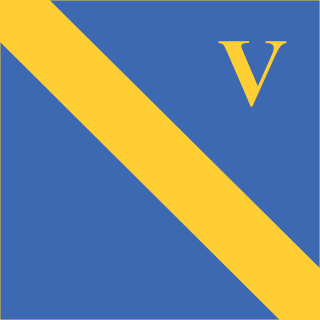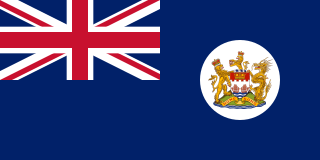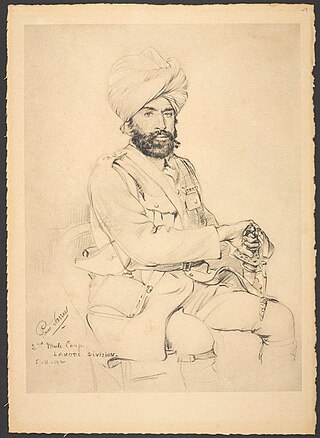Related Research Articles
The Infantry of the British Army comprises 49 infantry battalions, from 19 regiments. Of these, 33 battalions are part of the Regular army and the remaining 16 a part of the Army Reserve. The British Army's Infantry takes on a variety of roles, including armoured, mechanised, air assault and light.

The 4th Infantry Division, also known as the Red Eagle Division, is an infantry division of the Indian Army. This division of the British Indian Army was formed in Egypt in 1939 during the Second World War. During the Second World War, it took part in campaigns in East Africa, Syria, North Africa and Italy. Post independence, the division is part of the I Corps and headquartered at Prayagraj.

British Army of the Rhine (BAOR) was the name given to British Army occupation forces in the Rhineland, West Germany, after the First and Second World Wars, and during the Cold War, becoming part of NATO's Northern Army Group (NORTHAG) tasked with defending the North German Plain from the armies of the Warsaw Pact. The BAOR constituted the bulk of British forces in West Germany, and was a part of British Forces Germany (BFG). British Forces Germany consisted of elements of the three service branches of the British Armed Forces based in West Germany; BAOR controlled Army units stationed there.

The 4th Infantry Division was a regular infantry division of the British Army with a very long history, seeing active service in the Peninsular War and Waterloo Campaign, the Crimean and Boer Wars and both World Wars. It was disbanded after the Second World War and reformed in the 1950s as an armoured formation before being disbanded and reformed again and finally disbanded on 1 January 2012.

The 5th Infantry Division was a regular army infantry division of the British Army. It was established by Arthur Wellesley, 1st Duke of Wellington for service in the Peninsular War, as part of the Anglo-Portuguese Army, and was active for most of the period since, including the First World War and the Second World War and was disbanded soon after. The division was reformed in 1995 as an administrative division covering Wales and the English regions of West Midlands, East Midlands and East. Its headquarters were in Shrewsbury. It was disbanded on 1 April 2012.

The 7th Infantry Division was an infantry division of the British Army, first established by The Duke of Wellington as part of the Anglo-Portuguese Army for service in the Peninsular War, and was active also during the First World War from 1914 to 1919, and briefly in the Second World War in 1939.

The Royal Gurkha Rifles (RGR) is a rifle regiment of the British Army, forming part of the Brigade of Gurkhas. Unlike other regiments in the British Army, RGR soldiers are recruited from Nepal, which is neither a dependent territory of the United Kingdom nor a member of the Commonwealth.

British Forces Overseas Hong Kong comprised the elements of the British Army, Royal Navy and Royal Air Force stationed in British Hong Kong. The Governor of Hong Kong also assumed the position of the commander-in-chief of the forces and the Commander British Forces in Hong Kong took charge of the daily deployment of the troops. Much of the British military left prior to the handover of Hong Kong to China in 1997. The present article focuses mainly on the British garrison in Hong Kong in the post Second World War era. For more information concerning the British garrison during the Second World War and earlier, see the Battle of Hong Kong.

The Punjab Regiment is the second oldest regiment still in service in the Indian Army, and is the most senior regional infantry regiment. It was formed from the 2nd Punjab Regiment of the British Indian Army in 1947 and has taken part in various battles and wars since, winning numerous honours for the same.

The King's Division is a British Army command, training and administrative apparatus designated for infantry regiments in the North of England.

The 5th Infantry Division is an infantry division of the Indian Army. It was raised during the second world war and fought in several theatres of war and was nicknamed the "Ball of Fire". It was one of the few Allied divisions to fight against three different armies - the Italian, German and Japanese armies.

The 1st Armoured Infantry Brigade was an infantry brigade of the British Army with a long history including service during both the First and the Second World Wars. It was based at Tidworth Camp. Previously, it has been designated 1st (Guards) Brigade, 1st Infantry Brigade, 1st Mechanised Brigade, and under the initial Army 2020 reforms assumed the title of 1st Armoured Infantry Brigade. Under the Future Soldier programme, the brigade merged with the 1st Artillery Brigade to form the 1st Deep Recce Strike Brigade Combat Team.

The 5th Infantry Brigade was a regular infantry brigade of the British Army that was in existence since before the First World War, except for a short break in the late 1970s. It was an Airborne Brigade from the early 1980s until amalgamating with 24th Airmobile Brigade, in 1999, to form 16 Air Assault Brigade.
The Malaya Command was a formation of the British Army formed in the 1920s for the coordination of the defences of British Malaya, which comprised the Straits Settlements, the Federated Malay States and the Unfederated Malay States. It consisted mainly of small garrison forces in Kuala Lumpur, Penang, Taiping, Seremban and Singapore.

The Border Regiment was a line infantry regiment of the British Army, which was formed in 1881 under the Childers Reforms by the amalgamation of the 34th (Cumberland) Regiment of Foot and the 55th (Westmorland) Regiment of Foot.
The Order of battle of the East African campaign shows the ground forces of both sides in East Africa on the date that the Italians declared war on Britain and France, 10 June 1940 and for the British and Commonwealth forces involved in the 1941 offensive.

The 3rd (Lahore) Division was an infantry division of the Indian Army and before 1895, the Bengal Army, first organised in 1852. It saw service during World War I as part of the Indian Corps in France before being moved to the Middle East where it fought against troops of the Ottoman Empire.
In September 1939, the British Army was in process of expanding their anti-aircraft and mobile assets. Among these new changes was the formation of Anti-Aircraft Command which was formed on 1 April 1939, and the 1st Armoured Division formed in 1937. The list below will include the British Army units, colonial units, and those units which were in the process of formation.
The 2nd Malaya Infantry Brigade was a regular infantry brigade formed in 1940 with its headquarters in Singapore following the wartime expansion and reinforcement of Malaya Command. The Brigade participated in the Malayan Campaign and the Battle of Singapore against the Japanese until the surrender of the garrison in February 1942.
References
- 1 2 3 Milestones of Flight Archived 2011-01-05 at the Wayback Machine
- ↑ Heritage appraisal of King's College Archived 2012-09-08 at the Wayback Machine
- ↑ Queen's Royal Surreys
- ↑ Glasgow Herald, 25 January 1927